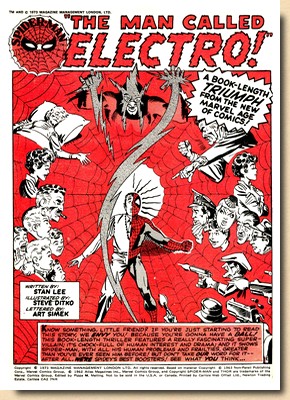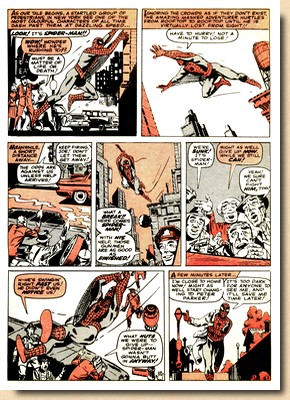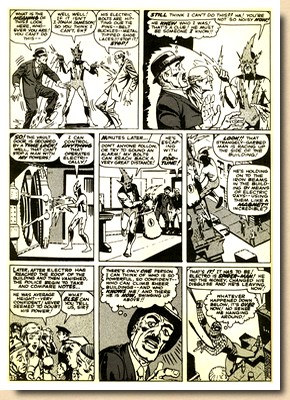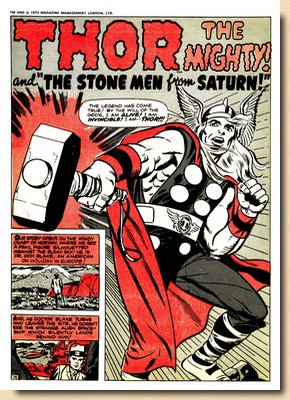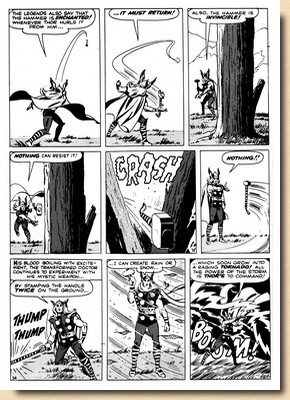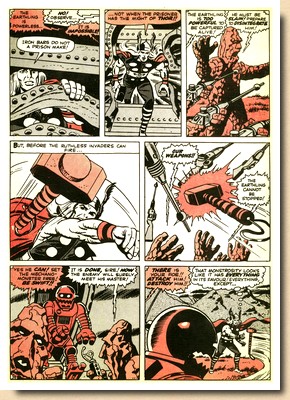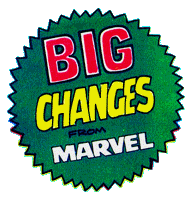| |
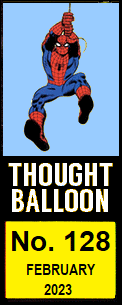 |

 SPOTLIGHT
ON SPOTLIGHT
ON
MARVEL
UK's
SPIDER-MAN
COMICS WEEKLY #1
(FEBRUARY
1973)
|
|
|
|
| |
|
| |
SPIDER-MAN
"The
Man called Electro!"
(22 pages)
Full
reprint, originally published in Amazing
Spider-Man #9 (February 1964)
Story - Stan Lee
Pencils & Inks - Steve Ditko
Lettering - Artie Simek
THOR
"The
Stone Men from Saturn!"
(13 pages)
Full
reprint, originally published in Journey Into
Mystery #83 (August 1962)
Story - Stan Lee
Pencils -
Jack Kirby
Inks - Joe Sinnott
Lettering - Artie Simek
The cover is composed of cover
artwork by Steve Ditko from Amazing
Spider-Man #19 and John Romita from Mighty
Thor #169
|
|
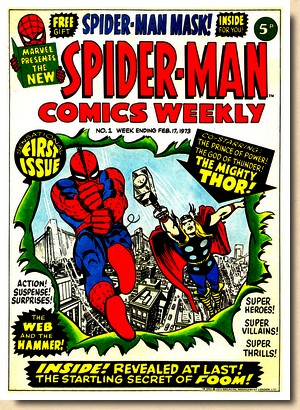 Spider-Man Comics
Weekly #1 Spider-Man Comics
Weekly #1
(UK, 17 February 1973)
|
|
| |
|
| |
| |
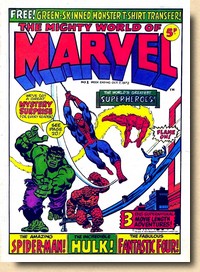
Mighty
World Of Marvel #1
(UK, October 1972)
|
|
WELCOME TO THE
MIGHTY WORLD OF MARVEL ...
On the last Saturday of
September 1972, a new comic book appeared on
British newsagent stands. Cover dated "week
ending Oct. 7, 1972", Mighty World of
Marvel #1 heralded the beginning of Marvel
UK (as the House of Ideas' British imprint would
soon be known as).
The first issue of Mighty
World of Marvel (which would quickly acquire
the affectionate acronym of MWOM)
started out with the origin stories of the Hulk,
the Fantastic Four and Spider-Man, and quickly
proved to be the huge success Marvel no doubt had
hoped for. A little more than four months and 19
issues after the launch of MWOM, Marvel
UK made its next move to increase its share of
the British market by launching their second
weekly on February 10th 1973.
...
HERE COMES THE SPIDER-MAN !
Swinging his way out of
the pages of MWOM, Spider-Man became the
leading character and star of Spider-Man
Comics Weekly (SMCW for short -
both editorial and the readers loved acryonyms),
which also introduced Thor as a backup strip.
|
|
| |
|
| |
| British
comic books at the time were generally published
weekly and black and white in order to cut down
on costs. Marvel UK followed the weekly
publication schedule but decided to use single
tints of so-called "spot colours" on
certain pages in order to set their comics apart
from other titles.
While
MWOM would feature a green tone (which
worked well with the Hulk material), the tone
chosen for SMCW was red. Again a fairly
obvious choice, it certainly gave the interior
pages printed that way a very different feel,
compared to the standard black and white printing
readers would get from other publisher's titles.
|
|
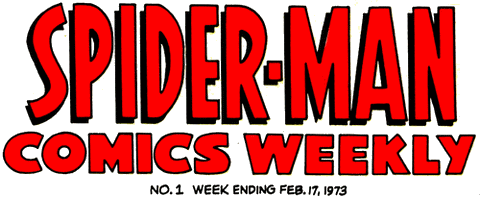
|
|
| |
| It may also have served the purpose of justifying the
higher price - whilst Spider-Man Comics Weekly
started out at a price of 5p, other and indeed more
established UK titles could still be purchased for 3.5p (Tiger),
3p (Wizard) or even just 2p (the asking price in
1973 for both The Dandy and The Beano). |
| |
|
| |
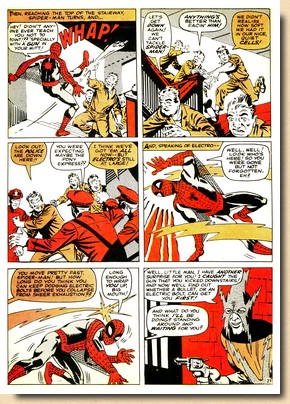
|
|
Attractive as it could be,
printing some interior pages with spot colours
certainly added to the overall production costs.
| Nevertheless, Marvel UK
even added a second spot colour (yellow)
to certain pages as of their third weekly
production cycle, and thus first
appearing in Mighty World Of Marvel #3
in mid-October 1972. Whilst still
miles from full colour rendition, it did
look rather snazzy and certainly gave the
end product a higher production value
look. It may also have spurred the
regular demands from readers for full
colour interior pages - something which
of course was out of the question (as
editorial patiently kept reminding
readers on the letters pages) for reasons
of printing cost and resulting cover
price for a single issue.
|
|
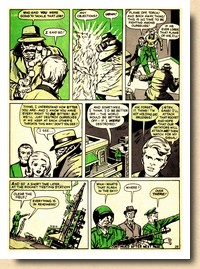
Mighty
World Of Marvel #3
(UK, October 1972)
|
Spider-Man Comics Weekly
continued the by then established practice and
also featured a few interior pages printed in two
spot colours, i.e. red and yellow. It really made
quite the difference to just black and white.
|
|
| |
| Of course the addition of yellow was actually just
the absence of any other mixing colour, since yellow is
what is called a "subtractive primary" in basic
colour printing. Mixing it with "cyan" (blue)
produces green colours, while yellow mixed with
"magenta" (purple) results in reds. Since
yellow was involved anyway, it was therefore not much of
an added expense to just use 100% yellow in some places
(and 25% in others for a lighter composite colour)
instead of just flat-out 50% to render green or red spot
colours. The spot colours lasted until mid-1973, with
Mighty World Of Marvel #42
and Spider-Man Comics Weekly #23 (both on sale at the news agents
the week ending July 21st 1973) being the last to feature them. From
there on out, interior pages were all black and white,
the only colour present being on the (by then) glossy
covers. Even though Mighty World Of Marvel #43
and Spider-Man Comics Weekly #24 - the
first issues without spot colours - introduced Marvel
UK's very own Bullpen Bulletin, no mention of this change
was made. There was also no immediate reactions in the
letters pages of both titles, so either readers had never
really cared for the spot colours, or editorial decided
to just let it go without any further ado (inclduing not
printing any letters commenting on the fact).
|
| |
| Since Spider-Man had been one of the three features
of Mighty World Of
Marvel since the get go of that title (the other two
being the Hulk and the Fantastic Four), the reprints of
his US material simply continued into
Spider-Man
Comics Weekly. As a consequence, readers who picked
up SMCW #1 without ever having read a single
copy of MWOM would be at something of a loss as
to who and what Spider-Man actually was. Some sort of
introduction page, would have been a possibility, but
Marvel UK seemed to give priority to advertising FOOM
(more of this later) and thus the total page count was
put to that use and Spidey was simply set loose with a
reprint of
Amazing
Spider-Man #9 (February 1964). The story marked the first
appearance of Electro, which was reprinted in full. At
the time, there was still more than enough distance in
time between the publication of the original material in
the US and their reprints in Britain. However, given the
weekly schedule of Marvel UK's titles, they would get
through the original material (that had been and still
was published monthly) rather quickly. Adding more
features to their titles would allow Marvel UK to slow
that process down a bit, and full reprints of US issues
would soon become the exception.
|
| |
| Thor, on the other hand, although having featured in
some haphazard 1960s UK reprints before, was a brand new
addition to the ranks of Marvel UK. |
| |
|
| |
| The Mighty Thor made his first appearance in
Journey Into Mystery #83
(August 1962) as "the most exciting superhero of all
time" (according to the cover blurb), and it is this origin
story - recounting how handicapped Doctor Don Blake
discovers Thor's hammer in a cave in Norway and then
turns into the Norse Thundergod himself by tapping his
cane on the ground - that is reprinted in full in Spider-Man
Comics Weekly #1. Thor stands out somewhat from
the other early Marvel superheroes, being an Asgardian
god and not the result of scientific experiments (such as
Ant-Man or Iron Man) or mishaps (as in the case of the
Fantastic Four or Spider-Man). According to Stan Lee, it
was the result of musing about a new superhero.
"How do you make someone stronger than
the strongest person? It finally came to me: Don't
make him human - make him a god [and] delve into the
old Norse legends (...) After writing an outline
depicting the story and the characters I had in mind,
I asked my brother, Larry [Lieber], to write the
script because I didn't have time." (Stan
Lee, in Lee & Mair 2002).
Of course, as is par for the course for any first
generation Marvel superhero, Jack Kirby would later
contest Lee's version regarding the creation of Thor and
claim sole authorship himself.
"I created Thor at Marvel because I was
forever enamored of legends, which is why I knew
about Balder, Heimdall, and Odin. I tried to update
Thor and put him into a superhero costume, but he was
still Thor." (Jack Kirby, in Van Hise 1985)
And as always, these questions tend to be answered by
some people based more on what they prefer to believe
than actual hard facts.
|
| |
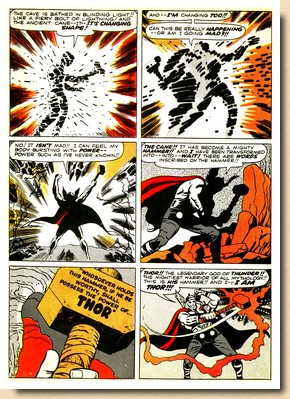
|
|
Kirby was in charge of the
artwork (inked by Joe Sinnott) and thus most
certainly came up with the soon-to-be-classic
visuals of Thor (whilst the Stone Men from
Saturn, on the other hand, were a clear swipe by
Kirby from his own work, a 1959
story he did for DC's House of Mystery). But
as far as actual characterization and content
goes, everything points to Larry Lieber, who was
writing actual full scripts based on Lee's
outline plots (Thomas, 1999). There was no
"Marvel Method" (i.e. giving artists
little more than a general plot and leaving the
layout of the pages to their discretion) in the
beginning of Thor's adventures in Journey
Into Mystery.
"Larry definitely did the first
Thor, and he may have written the copy for
Iron Man. What I did was give him the plot
and he wrote it." (Stan Lee, in
Thomas 1998)
Also rather unlike most Marvel superhero yarns
at the time, the Thor stories in Journey Into
Mystery remained uncredited until issue #86
(November 1962). For obvious reasons, that was
thus also the case for Thor's introduction in SMCW
#1.
Initially, both Thor as a character and his
storylines felt somewhat strange, as he
indiscriminately battled aliens, time-travelling
villains and communist bad guys alike. It took a
while for the Asgardian epic to settle in, but
once it did, Thor became one of Marvel's major
and best-selling superheroes.
|
|
| |
| Thor's origin story in Spider-Man Comics Weekly
#1 was reprinted using the same "spot colour"
technique as the Spider-Man story, resulting in black and
white pages as well as those with red and red plus yellow
hues. The latter was used, to quite a stunning effect, on
the page showing the first transformation of Don Blake
into Thor. |
| |
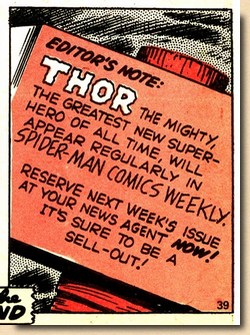
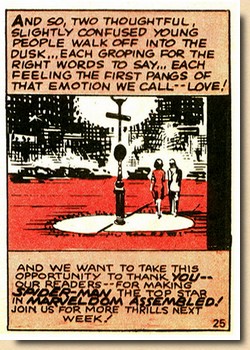
|
|
Back in the US in 1962, readers
were told that Thor would be a regular fixture in
Journey Into Mystery, and while the same was true
for the UK in 1973, the title required the
obvious change to Spider-Man Comics Weekly.
Editorial at Marvel UK also took the
opportunity to correct a spelling mistake in the
original (Thorr) and to replace the US term
"newsdealer" with the British
"news agent". Initially, quite an
effort was put into "anglicizing" what
Marvel UK's editorial felt was too American in
terms of language, or a reference British readers
would not understand.
Some alterations, however, seem rather
arbitrary or even puzzling - and the ending of
the Spidey story in SMCW #1 might be
considered a case in point.
The original last panel of Amazing Spider-Man #9
ends with no reference really needing a
correction (as would be the case in "see you
next month"); nevertheless, the last box of
text was completely changed. Was it to keep
pushing the new title ("Spider-Man, the top
star of Marveldom Assembled"), or did
editorial not want readers to think that
Spider-Man was "the super-hero who could be
- you"?
The person doing those alterations in 1972 and
1973 was 23-year-old Dave Gibbons (who would
later go on to create Watchmen with
writer and fellow Brit Alan Moore).
"I did all the anglicizing of
spelling in the first year or so of MWOM. As
it generally involved lengthening words
("colour" for "color",
say), I often had to redo whole lines of
copy." (Dave Gibbons, in Stringer
2007)
|
|
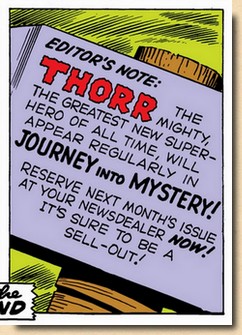
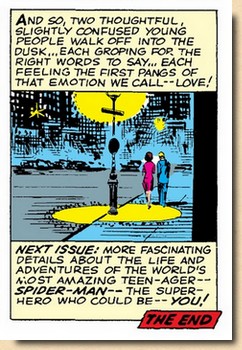
|
|
| |
It all started right at the outset of Marvel UK, and
- as one would suspect - it was a tedious job.
"I got a call from a guy called Rob
Barrow [who had] heard from a lady called, I believe,
Pippa Melling who was the de facto editor of the
about-to-start MWOM. The production prints they'd
received from the States still had US spelling. Rob
knew that I'd done lettering for Fleetway and thought
I would be just the man. I met up with Pippa in the
offices they then had in High Holborn and agreed the
details (...) I worked on high quality prints mounted
on heavy board, using strips of patch paper to do the
corrections. A fiddly business (...) I had to cut the
patch with a scalpel held at an angle, to chamfer the
edges and prevent shadow, then go round each edge
with white-out, just to make sure (...) I would get
pages through the mail, do the corrections and mail
them back, usually under a tight deadline. I can't
remember when or how I stopped, but I would guess
that they took to doing the corrections in the
US." (Dave Gibbons, in Stringer 2007)
|
| |
|
| |
SPREADING
THE NEWS
|
| |
| When Marvel UK started out in October 1972 with Mighty
World of Marvel #1, it wasn't just about reprinting
material previously published in the United States -
after all, most of it had already been published in the
UK in the 1960s in some shape or form. The real novelty
was the inclusion of the Marvel house style. Inspired by the way
how William Gaines and his EC Comics reached out to and
involved readers of their titles in the early 1950s, Stan
Lee understood (possibly like no other) the magic of
creating something of a club atmosphere and making
readers feel that they were actually part of something
special.
"I
didn't want us to be doing these books in a vacuum,
because you know comic books had no advertising
budget, no promotion. There were no ads on
television, on the radio, in newspapers - you just
printed your comic book and it was out there, and I
was (...) on a crusade, a mission, to let the world
know about the marvelous world of Marvel. So in that
sense, I guess I was a little bit of a
huckster." (NN, 2003)
|
| |
 |
|
In the case of
launching Spider-Man Comics Weekly #1,
however, it seems that Marvel UK did in fact run
a few TV commercials (Carroll, 2019). But the
main advertising space was, of course, Mighty
World of Marvel, and it served that
billboard function well.
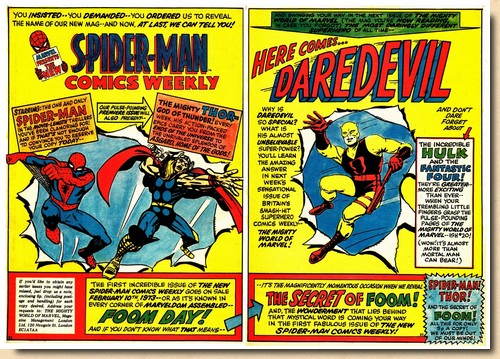
In-house ad from Mighty
World of Marvel #19 (February 1973)
The first
issue featured Stan Lee "sounding off"
in his very own column (quite like his soapbox in
the US titles) in his usual style of avuncular
hyperbole.
"Remember
when we told you that mighty Marvel was
taking over the world? Hah! And you thought
we were kidding!"
Apart from
a plug for Mighty World of Marvel
(where Daredevil was to take Spider-Man's now
vacant spot, heralding the shape of things to
come as more classic Marvel characters would
gradually be introduced to UK readers), Spider-Man
Comics Weekly #1 was
also
used to promote the UK branch of Marvel's
in-house fan club FOOM (Friends Of
Ol' Marvel), the "secret" of which
had been trumpeted up in several previous issues
of MWOM.
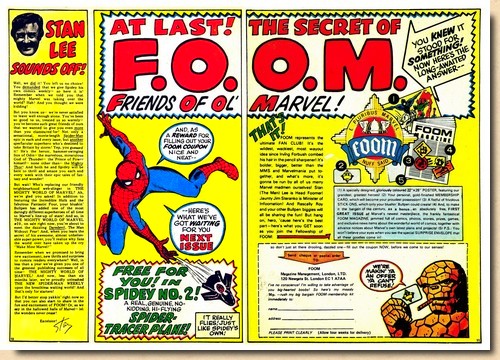
Launching
FOOM (Marvel's third fan club after the original Merry
Marvel Marching Society of the 1960s and the
short-lived subsequent Marvelmania
International) was a clear indication that
the House of Ideas had identified the UK as a
very promising market and was looking to increase
and strengthen what would today be called
"customer loyalty" amongst its current
and future readers.
|
|
| |
| Keeping up the British comic book tradition of free
gifts in the first few issues of a new title (Mighty
World of Marvel #1 came with a Hulk iron-on
transfer), Spider-Man Comics Weekly #1 promised
nothing less than a Spider-Man Mask on its cover. In a
somewhat sobering reality check, this turned out to be
nothing more than a printed paper bag (Stringer, 2007). |
| |
|
| |
BE
PUBLISHED FOR LONG AND PROSPER
|
| |
| Spider-Man was the flagship character of the House of
Ideas (although the Hulk always came a close second in
the UK in terms of popularity), and Marvel UK no doubt
had high hopes that Spider-Man Comics Weekly,
alongside Mighty World of Marvel, would take
their entry into the British comic book market to the
next level. And it did. |
| |
|
Ultimately,
Spider-Man
Comics Weekly would become the
longest-running UK Marvel comic book (enjoying a
continuous run over a period of 12 years),
although it changed its title name several times
(and with increasing frequency once it was beyond
the 150 issues mark): - Super Spider-Man with the
Super-Heroes (as of issue #158)
- Super Spider-Man and the Titans (#199)
- Super Spider-Man and Captain Britain
(#231)
- Spider-Man Comic (#311)
- Spectacular Spider-Man Weekly (#334)
- Spider-Man and Hulk Weekly (#376)
- Super Spider-Man TV Weekly (#450)
- Spider-Man and his Amazing Friends (#553)
- Spider-Man Comic (#634)
- Spidey Comic (#652)
|
|
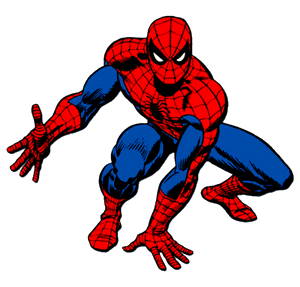
|
|






